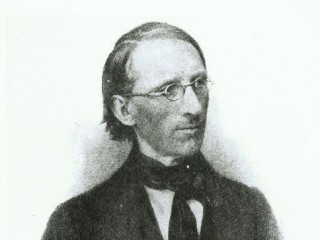
Karl Friedrich Wilhelm Ludwig biography
Date of birth : 1816-12-29
Date of death : 1895-04-23
Birthplace : Witzenhausen, Hessen
Nationality : German
Category : Arhitecture and Engineering
Last modified : 2011-10-10
Credited as : Psysiologist, Kymograph, Mercurial blood-gas pump
The German physiologist Karl Friedrich Wilhelm Ludwig (1816-1895) was one of the leading experimental physiologists of the 19th century and invented a number of important pieces of laboratory equipment.
On Dec. 29, 1816, K. F. W. Ludwig was born at Witzenhausen, Hessen. He was educated at the universities of Erlangen and Marburg and received his doctorate from Marburg in 1839. He was appointed lecturer in physiology at Marburg in 1842 and associate professor of comparative anatomy in 1845. In 1843-1844 Ludwig put forward his theory that urine was formed by a filtration process in the kidneys. Later (1870) Ludwig modified the original theory to give the basis of the modern theory about the formation of urine. While still at Marburg he developed the kymograph, an instrument used to record physiological variables in graphical form. This invention was one of a number which helped him live up to his aim to place "physiology on a chemicophysical foundation, and give it equal rank with physics."
In 1849 Ludwig was appointed to the chair of anatomy and physiology at the University of Zurich. At Zurich he and his pupils studied the formation of lymph, the mechanism of glandular secretion, and the nervous control of blood vessels. In 1855 Ludwig left Zurich to take a chair of physiology and zoology in Vienna. Here he continued his studies of the blood and the way in which the nervous system controlled its circulation. At Vienna he also invented the mercurial blood-gas pump for separating gases from the blood.
In 1865 Ludwig accepted a chair in physiology at the University of Leipzig. Here he was the foundation director of the Institute of Physiology, which under his direction became a renowned graduate school that attracted students from many countries. Ludwig investigated capillary blood pressure, introduced techniques to keep individual organs "alive" outside the body, and invented the stromuhr, which measured the flow of blood in a vessel.
It was Ludwig's custom to allow his students to publish under their own names work to which he had made substantial contributions. Frequently he not only designed the experimental procedure but also did much of the laboratory work and wrote the final draft of the paper. Ludwig's contributions to science were acknowledged when he was elected a foreign member of the Royal Society in 1875 and when he was awarded the society's Copley Medal in 1884. He died in Leipzig on April 23, 1895.
There is no full-scale biography of Ludwig readily available in English. A full account of much of his work is in Alfred P. Fishman and Dickinson Richards, eds., Circulation of the Blood: Men and Ideas (1964), which can be supplemented with Fielding H. Garrison, An Introduction to the History of Medicine (1913; 4th ed. 1929). □
















